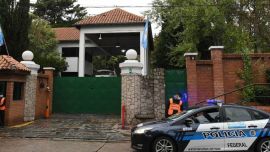Oil paintings, ink sketches, sculptures in wood and bronze – Adolfo Pérez Esquivel, recipient of the Nobel Peace Prize in 1980, is making public his other life in art.
Last weekend, the human rights campaigner opened a new exhibition collating his work from the 1950s to the modern day.
Pérez Esquivel, an intense militant in defence of human rights who was tortured as a prisoner during the 1976-1983 military dictatorship, is less well known as an architect and artist, the subject of his studies at La Plata University and the Escuela Nacional de Bellas Artes.
But with the exception of a series of drawings of the La Boca neighbourhood from the 1950s and portraits of his wife Amanda and son Ernesto, his new exhibition at the Lucy Mattos Museum in the Greater Buenos suburb of Béccar (San Isidro) displays work reflecting a strongly political component.
"For me there is no difference between art and life, it’s the same thing. It’s the form of saying something which you carry inside and want to transmit," said Pérez Esquivel in an interview with the AFP news agency.
Drawings of the bombardment of an Iraq refuge in 2001 and a trip to Hiroshima are exhibited along with the acrylic sketch entitled La virgen de los cartoneros (as those who recycle rubbish are called in Argentina).
"That work will end up going to the cartoneros. They know it and are waiting for it," he pointed out, adding: "Nobody taught me poverty since I was one of the poor."
‘Art remains’
Born in 1931 in Buenos Aires City, Pérez Esquivel lost his mother at a very young age and was left to the care of nuns in a boarding school and his maternal grandmother, of indigenous and Guaraní origin.
"Iraq and Hiroshima were scenarios in which I participated. They didn’t tell me, I was there. Art generates memory. We pass on and art remains," he asserts, discussing the warlike images.
The exhibition also includes a painting of the refugees whom he got to know on the island of Lesbos (Greece) and episodes of contemporary Argentine history.
Laura Casanovas, the curator of the exhibition, explained that in the case of Pérez Esquivel, "art was never excised from struggle.”
“The ink drawings, the woodcuts, the acrylic paintings, the watercolours and the sculptures all uncover different stylistic stages with artistic proposals as much close to realism as to vanguard, above all with Latin American roots, but with their own formal solutions,” she adds.
Although Pérez Esquivel has a mural in the cathedral of Riobamba (Ecuador) another in Curitiba (Brazil) and a sculpture in tribute to Gandhi in Barcelona (Spain), among other permanently installed works, this exhibition is his first in over 40 years.
"I’ve had many occupations and time goes by," he justifies not having organised an exhibition previously.
Spirituality
At the age of 90, and following a recent stroke, he still keeps on painting. At the moment he is recreating The Last Supper in a work still in progress and in which he will include the Virgin Mary and Mary Magdalene, along with the 12 disciples.
With his profound religious beliefs, Pérez Esquivel was very close to the Theology of Liberation and was a militant of Christian movements based on non-violence. His paintings highlight the main figures of that strand, such as the archbishops Helder Camara of Brazil and Arnulfo Romero of El Salvador.
"I passed through torture and the death flights but I never entered into existential anguish. It was my spirituality which saves me and saved me from seeing the horror and the death," says this slow-spoken man who barely needs a stick to walk.
Of the paintings on display, one of his favourites is La muerte enamorada de la vida (“Death in love with life”), in which a skull offers a flower to a seated woman.
"Life and death are the same things. There is not one without the other," he affirms.
related news
by Nina Negrón, AFP






















Comments